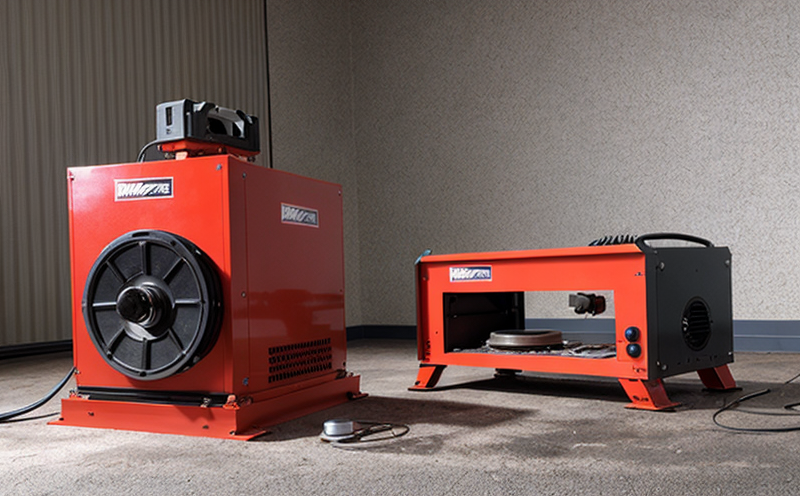MIL-STD-202 Mechanical Shock Testing for Electronic Components
The MIL-STD-202 Method 215.6 provides a standardized approach to testing electronic components for their resistance to mechanical shock. This test is crucial in ensuring the reliability and durability of electronic devices, especially those deployed in harsh environments where they are exposed to sudden mechanical impacts.
Understanding how products behave under these conditions can help manufacturers identify potential weaknesses early on, improving overall product design and reducing failure rates in field use. Compliance with MIL-STD-202 is often a requirement for military and aerospace applications, but the lessons learned from this testing are applicable to many other sectors where mechanical shock might occur.
The test involves subjecting the electronic component to a controlled impulse of force (mechanical shock) that simulates real-world conditions. The goal is to determine if the device can withstand such shocks without sustaining damage or degradation in performance. This service ensures that components meet the stringent requirements set forth by MIL-STD-202, thereby enhancing their reliability and robustness.
During testing, engineers carefully prepare specimens according to specific guidelines provided within the standard. These preparations include selecting appropriate test parameters based on the intended use of the component. The apparatus used for conducting these tests includes specialized shock testers capable of generating controlled impulses of force that mimic actual field conditions accurately.
The acceptance criteria for MIL-STD-202 mechanical shock testing are designed to ensure that components can withstand specified levels of shock without failing. Components that pass this test demonstrate their ability to function properly even after being subjected to severe mechanical shocks, which is critical information for quality assurance teams and compliance officers responsible for ensuring product safety and reliability.
For R&D engineers involved in developing new products or improving existing ones, MIL-STD-202 testing provides valuable insights into how electronic components perform under extreme conditions. By incorporating this data early on in the design process, manufacturers can make informed decisions about material selection, structural integrity, and overall product architecture.
Testing according to MIL-STD-202 also supports procurement efforts by ensuring that purchased components meet rigorous quality standards before integration into larger systems or assemblies. This precludes costly rework later down the line due to non-compliant parts and helps maintain consistent performance across all units manufactured.
Scope and Methodology
| Parameter | Description |
|---|---|
| Test Specimen | The electronic component being tested, chosen based on its intended use. |
| Impulse Force | The controlled force applied to the specimen during testing. This is determined by the specific requirements outlined in MIL-STD-202. |
| Shock Duration | The duration of time over which the impulse force acts on the specimen, also specified in accordance with MIL-STD-202 guidelines. |
| Test Environment | The conditions under which testing takes place, ensuring that they closely mimic real-world scenarios experienced by the component during operation. |
| Data Collection | Measurement of various parameters related to the performance and integrity of the specimen throughout the test. This includes displacement, velocity, acceleration, and more. |
The methodology for conducting MIL-STD-202 mechanical shock tests involves precisely controlling all relevant variables so that results are repeatable and consistent across multiple trials. Compliance with these detailed procedures ensures accurate assessment of the specimen's ability to withstand specified levels of mechanical shock.
Testing according to MIL-STD-202 is not just about passing a single test; it’s about demonstrating ongoing reliability over time. By incorporating this testing into your quality control processes, you can ensure that even after repeated exposure to mechanical shocks, your electronic components continue to perform reliably and meet all necessary standards.
Industry Applications
MIL-STD-202 mechanical shock testing finds application across various industries where reliability under extreme conditions is paramount. Military and aerospace applications are obvious examples due to the harsh environments these products often operate in. However, this testing also applies to other sectors such as automotive electronics, medical devices, and consumer goods.
For instance, automotive manufacturers use MIL-STD-202 testing to ensure that their electronic components can withstand the jarring forces experienced during crashes or sudden stops. In the medical field, it helps verify that implantable devices remain functional despite potential impacts during patient transport or other activities.
The consumer electronics industry benefits from this testing too as products like smartphones and tablets must survive drops onto hard surfaces without malfunctioning. By adhering to MIL-STD-202 standards, manufacturers can enhance customer confidence knowing their products meet robust quality benchmarks.
Quality managers overseeing production processes need assurance that every batch of components meets these stringent requirements consistently. Compliance officers ensure regulatory compliance while R&D engineers leverage test results for continuous improvement efforts aimed at enhancing product durability and performance.
Why Choose This Test
- Ensures reliability under extreme conditions, critical for military and aerospace applications.
- Provides valuable data for ongoing improvements in electronic component design.
- Safeguards against costly rework due to non-compliant parts during procurement processes.
- Maintains consistent performance across all manufactured units, enhancing overall quality assurance efforts.
- Achieves regulatory compliance while supporting continuous improvement initiatives within the organization.
- Verifies that components can withstand specified levels of mechanical shock without failure.
By choosing MIL-STD-202 mechanical shock testing for electronic components, organizations demonstrate their commitment to delivering high-quality products capable of withstanding real-world challenges. This testing not only protects against potential failures but also fosters innovation by providing insights into how components behave under stress.





